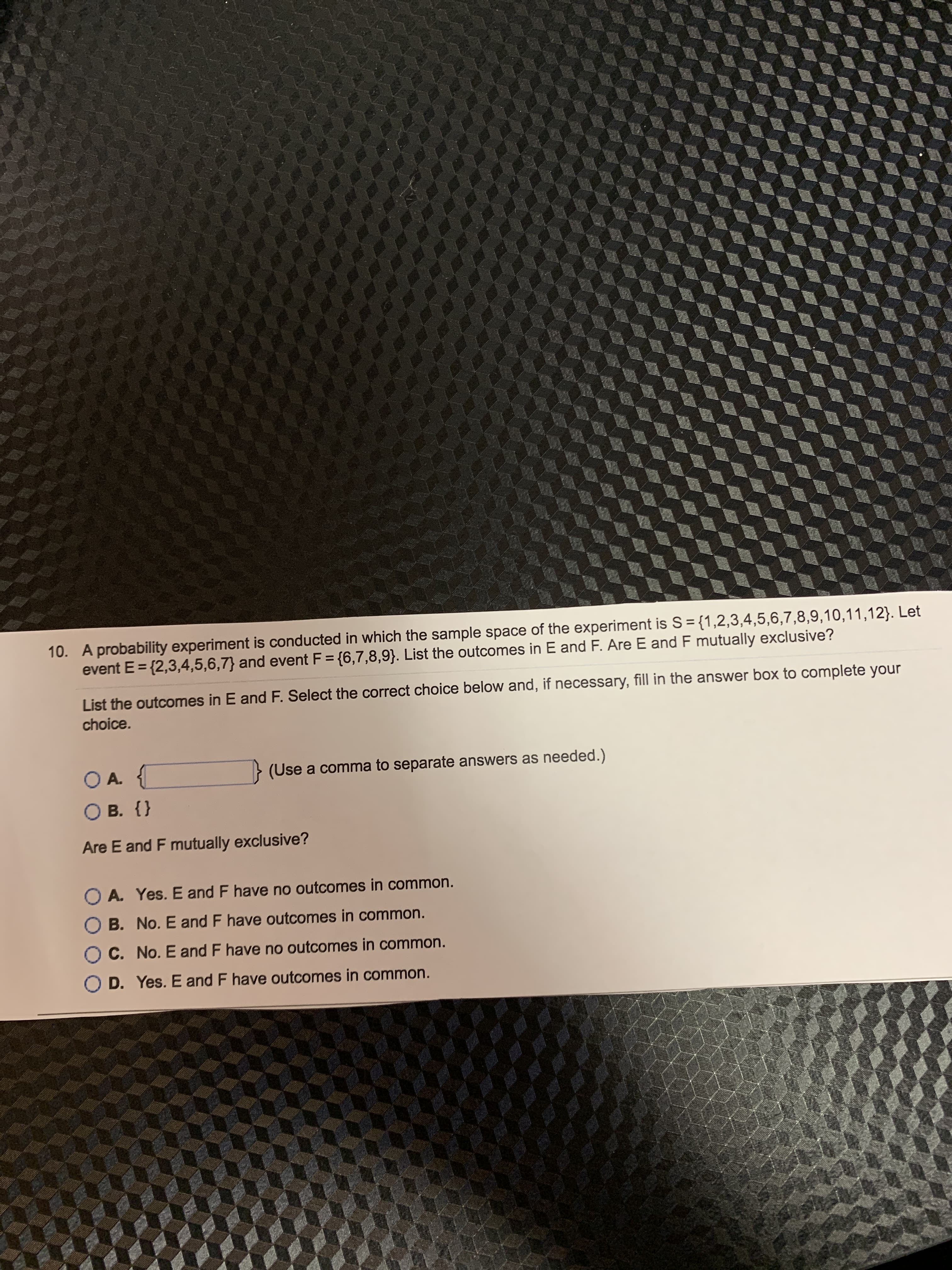10. A probability experiment is conducted in which the sample space of the experiment is S = {1,2,3,4,5,6,7,8,9,10,11,12}. Let event E = {2,3,4,5,6,7} and event F = {6,7,8,9}. List the outcomes in E and F. Are E and F mutually exclusive? %3D List the outcomes in E and F. Select the correct choice below and, if necessary, fill in the answer box to complete your choice. OA. > (Use a comma to separate answers as needed.) O B. {} Are E and F mutually exclusive? O A. Yes. E and F have no outcomes in common. O B. No. E and F have outcomes in common. O C. No. E and F have no outcomes in common. O D. Yes. E and F have outcomes in common.
10. A probability experiment is conducted in which the sample space of the experiment is S = {1,2,3,4,5,6,7,8,9,10,11,12}. Let event E = {2,3,4,5,6,7} and event F = {6,7,8,9}. List the outcomes in E and F. Are E and F mutually exclusive? %3D List the outcomes in E and F. Select the correct choice below and, if necessary, fill in the answer box to complete your choice. OA. > (Use a comma to separate answers as needed.) O B. {} Are E and F mutually exclusive? O A. Yes. E and F have no outcomes in common. O B. No. E and F have outcomes in common. O C. No. E and F have no outcomes in common. O D. Yes. E and F have outcomes in common.
MATLAB: An Introduction with Applications
6th Edition
ISBN:9781119256830
Author:Amos Gilat
Publisher:Amos Gilat
Chapter1: Starting With Matlab
Section: Chapter Questions
Problem 1P
Related questions
Question

Transcribed Image Text:10. A probability experiment is conducted in which the sample space of the experiment is S = {1,2,3,4,5,6,7,8,9,10,11,12}. Let
event E = {2,3,4,5,6,7} and event F = {6,7,8,9}. List the outcomes in E and F. Are E and F mutually exclusive?
%3D
List the outcomes in E and F. Select the correct choice below and, if necessary, fill in the answer box to complete your
choice.
OA.
> (Use a comma to separate answers as needed.)
O B. {}
Are E and F mutually exclusive?
O A. Yes. E and F have no outcomes in common.
O B. No. E and F have outcomes in common.
O C. No. E and F have no outcomes in common.
O D. Yes. E and F have outcomes in common.
Expert Solution
This question has been solved!
Explore an expertly crafted, step-by-step solution for a thorough understanding of key concepts.
Step by step
Solved in 2 steps with 2 images

Recommended textbooks for you

MATLAB: An Introduction with Applications
Statistics
ISBN:
9781119256830
Author:
Amos Gilat
Publisher:
John Wiley & Sons Inc

Probability and Statistics for Engineering and th…
Statistics
ISBN:
9781305251809
Author:
Jay L. Devore
Publisher:
Cengage Learning

Statistics for The Behavioral Sciences (MindTap C…
Statistics
ISBN:
9781305504912
Author:
Frederick J Gravetter, Larry B. Wallnau
Publisher:
Cengage Learning

MATLAB: An Introduction with Applications
Statistics
ISBN:
9781119256830
Author:
Amos Gilat
Publisher:
John Wiley & Sons Inc

Probability and Statistics for Engineering and th…
Statistics
ISBN:
9781305251809
Author:
Jay L. Devore
Publisher:
Cengage Learning

Statistics for The Behavioral Sciences (MindTap C…
Statistics
ISBN:
9781305504912
Author:
Frederick J Gravetter, Larry B. Wallnau
Publisher:
Cengage Learning

Elementary Statistics: Picturing the World (7th E…
Statistics
ISBN:
9780134683416
Author:
Ron Larson, Betsy Farber
Publisher:
PEARSON

The Basic Practice of Statistics
Statistics
ISBN:
9781319042578
Author:
David S. Moore, William I. Notz, Michael A. Fligner
Publisher:
W. H. Freeman

Introduction to the Practice of Statistics
Statistics
ISBN:
9781319013387
Author:
David S. Moore, George P. McCabe, Bruce A. Craig
Publisher:
W. H. Freeman